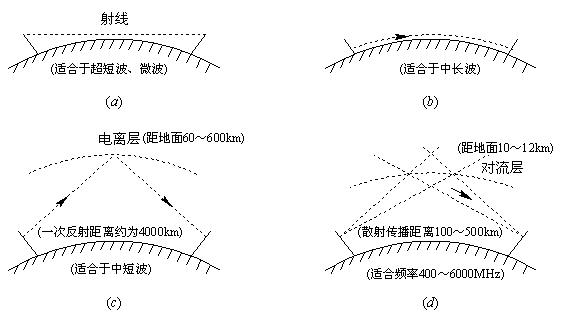Characteristics of radio signals
In high-frequency circuits, there are three main types of radio signals we want to process: baseband (message) signals, high-frequency carrier signals, and modulated signals. The so-called baseband signal is the original signal before modulation, which is also called modulated signal.
1. Time characteristics
(1) Signal description: A radio signal, which can be expressed as a time function of voltage or current, is usually described by time-domain waveforms or mathematical expressions.
(2) The concept of time characteristics: The time characteristics of radio signals are the characteristics of how fast the signal changes with time. The time characteristic of the signal requires that the time characteristic of the circuit that transmits the signal (such as the time constant) be adapted to it.
2. Spectrum characteristics?
For more complex signals (such as voice signals, image signals, etc.), it is more convenient to use spectrum analysis.
The concept of the spectral characteristics of a signal: The spectral characteristics of a signal are the characteristics of each frequency component in the signal.

For periodic signals, it can be expressed as many discrete frequency components (the components are in a harmonic relationship), for example, Figures 1-3 are the spectrum diagrams of the signals shown in Figures 1-2; for non-periodic signals, you can use Fu The method of Fourier transform is decomposed into continuous spectrum, and the signal is the integral of continuous spectrum.
The spectral characteristics include amplitude frequency characteristics and phase frequency characteristics, which respectively reflect the distribution of the amplitude and phase of each frequency component in the signal.
Any signal will occupy a certain bandwidth. From the perspective of spectrum characteristics, the bandwidth is the frequency range or frequency bandwidth occupied by the main part of the signal energy (generally more than 90%). ? 
Figure 1 — 3 Spectrogram
3. Propagation characteristics Propagation characteristics: refers to the propagation mode, propagation distance and propagation characteristics of radio signals. The propagation characteristics of radio signals are mainly distinguished according to the frequency band or band in which they are located. ?
After the electromagnetic wave is radiated from the transmitting antenna, not only the energy of the radio wave will be diffused, but the receiver can only receive a very small part of it, but during the propagation process, the energy of the radio wave will be absorbed or reflected by the ground, buildings or high-altitude ionosphere , Or it may cause refraction or scattering in the atmosphere, which will greatly reduce the intensity when it reaches the receiver. According to the phenomenon of radio waves in the propagation process, the propagation methods of radio waves mainly include direct (line-of-sight) propagation, diffraction (ground wave) propagation, refraction and reflection (sky wave) propagation, and scattered propagation, as shown in Figures 1 to 5. Show. The key factor that determines the propagation mode and propagation characteristics is the frequency of the radio signal. ? 
Figure 1-5 The main mode of radio wave propagation?
(A) Direct propagation; (b) Ground wave propagation; (c) Sky wave propagation; (d) Scattering propagation
4. Modulation characteristics?
Another reason why high frequency (radio frequency) is generally used for radio propagation is that high frequency is suitable for antenna radiation and wireless propagation. Only when the size of the antenna is comparable to the wavelength of the signal, the radiation efficiency of the antenna will be higher, so that with a smaller signal power spread over a longer distance, the receiving antenna can effectively receive the signal.
The so-called modulation is to use the modulation signal to control the parameters of the high-frequency carrier, so that one or several parameters (amplitude, frequency or phase) of the carrier signal change according to the law of the modulation signal.
According to the different modulation parameters of the carrier, modulation is divided into three basic modes, which are amplitude modulation (amplitude modulation), frequency modulation (frequency modulation), and phase modulation (phase modulation), which are respectively expressed by AM, FM, PM, and can also be combined Modulation.
A Phone Screen Protector is an accessory for cell phones, Pads, tablet computers, and other devices that protects the screen and keeping your screen intact.
phone screen protector preserves your screen from scratches that can happen in everyday encounters, not to mention the rough and tumble environment of your bag. You can feel confident knowing your shield may take a beating, but your phone's screen will remain as smooth and clean as the day you bought it .
iPhone 6 plus screen protector makes your lovely iPhone 6 plus Screen Clean and Pristine. It can prevents oils from adhering to your screen which means smudges and fingerprints wipe away easily.
You can get glass phone screen protectors made out of tempered glass. Like with any technology, they have their own pros and cons.
Our screen protector use for , iPhone 6 , iPhone 6 plus , 7 plus , iPhone 8 , 8 plus and etc .
Phone Screen Protector
Phone Screen Protector, Clear Phone Screen Protector, Smart Phone Screen Protector, Glass Phone Screen Protector,Phone Glass Protector
Hebei Baisiwei Import&Export Trade Co., LTD. , https://www.baisiweicable.com